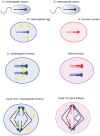Heterochromatin: a rapidly evolving species barrier
- PMID: 19830257
- PMCID: PMC2760774
- DOI: 10.1371/journal.pbio.1000233
Heterochromatin: a rapidly evolving species barrier
Abstract
Recent work has shown that changes in the sequence composition of heterochromatin, or in the factors that maintain that heterochromatin, may play an important role in speciation.
Conflict of interest statement
The authors have declared that no competing interests exist.
Figures


Comment on
-
Species-specific heterochromatin prevents mitotic chromosome segregation to cause hybrid lethality in Drosophila.PLoS Biol. 2009 Oct;7(10):e1000234. doi: 10.1371/journal.pbio.1000234. Epub 2009 Oct 27. PLoS Biol. 2009. PMID: 19859525 Free PMC article.
References
-
- Eissenberg J. C, Reuter G. Cellular mechanism for targeting heterochromatin formation in Drosophila. Int Rev Cell Mol Biol. 2009;273:1–47. - PubMed
-
- Brown M. Chiasma formation in the bobbed region of the X chromosome of Drosophila melanogaster. University of Texas Publication. 1940;4032:65–72.
-
- Muller H. J, Painter T. S. The differentiation of the sex chromosome of Drosophila into genetically active and inert regions. Z Indukt Abstammungs Verebungsl. 1932;62:316–365.
-
- Spofford J. B. Position-effect variegation in Drosophila. In: Ashburner M, Novitski E, editors. The genetics and biology of Drosophila. New York: Academic Press; 1976. pp. 955–1018.
-
- Karpen G. H, Schaefer J. E, Laird C. D. A Drosophila rRNA gene located in euchromatin is active in transcription and nucleolus formation. Genes Dev. 1988;2:1745–1763. - PubMed
Publication types
MeSH terms
Substances
LinkOut - more resources
Full Text Sources
Molecular Biology Databases

